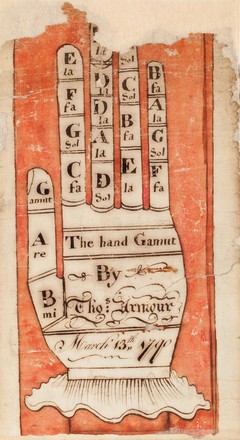
The hand gamut, 13 March 1790
RB/MSS090
Manuscript sight-singing tutor
Manuscript sight-singing tutor
The manuscript employs a method of sight-singing known as solmisation. Attributed to medieval Italian music theorist Guido of Arezzo (c. 991–after 1033), the set of six solmisation syllables — ut – re – mi – fa – sol – la — was used in the oral teaching of melodies. These ascending notes were known as the hexachord. A ‘hand gamut’ was a mnemonic device, or visual aid, on which solmisation syllables were mapped to parts of the human hand. A teacher would indicate which notes to sing by pointing to particular finger joints. Although it first appeared after Guido of Arezzo’s time, the hand gamut is frequently referred to as the Guidonian hand.
Footnotes
Meredith Lawn, Music Archivist,
State Library of NSW


 Back to list
Back to list